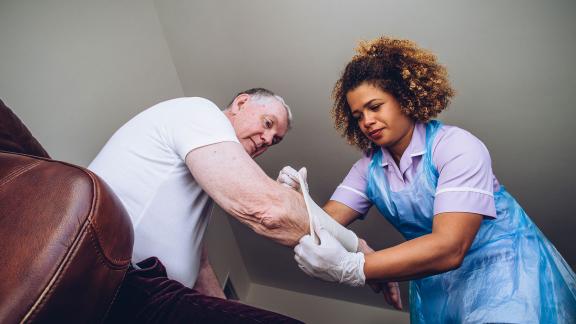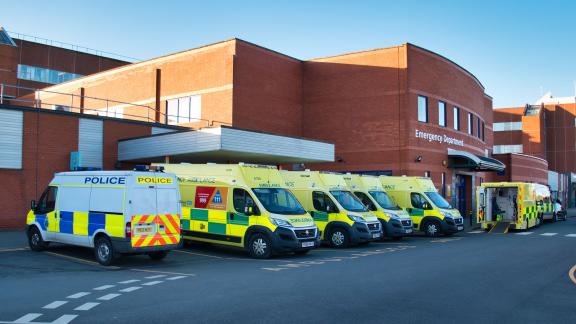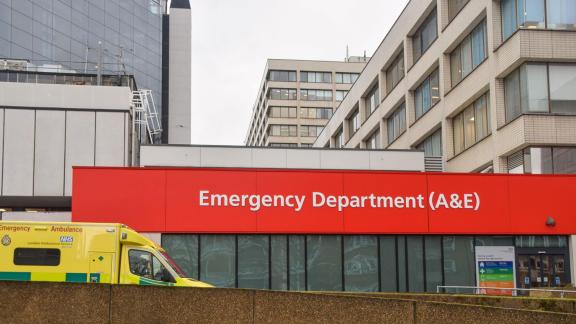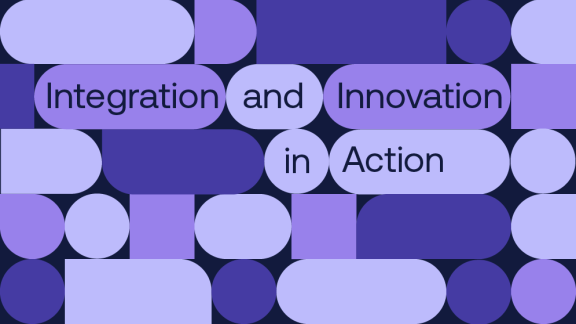Key points
- Mounting pressures in urgent and emergency care (UEC) are making it increasingly difficult to manage demand in a timely and effective way. Challenges in UEC, often seen as the ‘canary in the coalmine’, point to whole-system issues and signal a system at tipping point. NHS leaders are concerned that demand for urgent and emergency care and lengthening ambulance waits pose a risk to patient safety this winter.
- Healthcare leaders and clinical teams are doing all they can to ensure patients get the right care, in the right place, at the right time. But without fundamental change to the system at large, siloed solutions of the kind seen over the past few years will only tinker around the edges. As we have long argued, radical, whole-system solutions are needed to better support urgent and emergency care.
- Recognising the extreme challenges facing the UEC system, we sought views from a range of senior clinicians and healthcare leaders to get under the skin of the issues and consider potential ways forward. This report, supported by VitalHub, explores what we heard and presents five measures leaders and clinicians believe would improve patient care and outcomes.
- Participants identified a number of issues contributing to the challenges facing UEC, including: the complex nature of access (multiple entry points); risk not always being well understood or shared; little attention on solutions that support admission avoidance and prevention; and social care not often being seen as part of the solution.
- Our engagement found that greater clarity about access, consistent pathways, better risk-sharing, greater focus on urgent care, better use of data and investment in social care have the potential to support better, more joined-up patient care and improve flow.
- With NHS England developing a new urgent and emergency care strategy, these reflections should serve as a springboard to re-envision UEC in England. Thinking differently about how the system is joined up and works together is critical to ensuring a sustainable and cost-effective service can be delivered, and to maximise the vast array of skills and knowledge that exists.
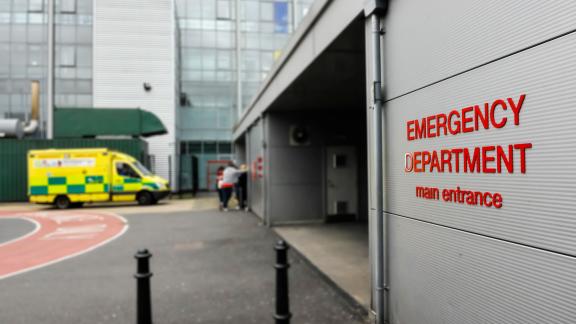
Foreword
Urgent and emergency care is undoubtedly complex, involving an array of different factors and multiple organisations and providers. There is no ‘one size fits all’ cure to make the system better, nor one single solution that will improve it. All parts of the health and social care system have improvements to make to get their own house in order.
Patient flow, especially in urgent and emergency care, has to be a team sport; it is not one provider’s problem but everyone’s responsibility to do what they can. The formation of integrated care boards brings the opportunity to join things up, share accountability, load balance risk and look more widely across existing pathways and organisational boundaries to do something different. Systems need permission to have the autonomy to break tradition and shift resource to where it is more appropriate, and not where it has always historically been.
The current infrastructure is confusing to navigate, not only for the public but also for staff working in the chaos. We have a tendency to just keeping ‘adding’ more – more services, more beds, more layers, more rules, which we expect staff to keep up with. This causes delays, drives inefficiencies and wastes precious time. Poor processes and lack of understanding inadvertently keep patients in places longer than they need to, creating more demand on the services required to fix the deconditioning the system has created – social care being at the brunt of that burden and finger pointing.
This report provides the foundations to start looking more widely beyond the walls of acutes and re-emphasises the importance of building better relationships and establishing trust. It reminds us to put ourselves in other people’s (services’) shoes and see things from their perspective.
There are several opportunities for change and it feels like now is the time to truly make that happen. Small improvements in all parts of the system can have a massive impact when they happen all at once.

Lisa Riley
Vice-President of Strategic Product and Partnership Development / Sales
VitalHub
Background
The image of a makeshift shelter keeping a man warm as he waited for an ambulance has come to typify the extreme pressures facing England’s urgent and emergency care system.
Over the last ten years there has been a 13 per cent increase in major emergency department (type 1) attendances. This uptick is making it increasingly difficult to manage demand in a timely and effective way – a task compounded by difficulties recruiting and retaining staff.
While rising demand has presented challenges for the system, it is by no means the sole factor. Length of stay, where patients are increasingly spending longer in hospital partly due to difficulties with discharge, presents another.
The last ten years have also seen changes to the usage and perception of the urgent and emergency care system, with it often viewed as a problem to be fixed, rather than a symptom of a system not addressing population health and care needs. The reasons for these changes are multifactorial and driven by both the population and how services are configured and funded.
Developing and delivering healthcare in a way that manages the changing needs and expectations of the public is challenging. While the health and care sector has adapted and innovated, a lack of investment, staffing issues and the COVID-19 pandemic have meant it has not recognised or kept pace with these changes.
To an extent, emergency medicine has been a victim of its own success. Seeing everyone for everything has led to high levels of popularity due to the relative ease of access when compared with other urgent care providers. Yet as explored in this report, clinicians and healthcare share the view that a significant portion of emergency departments’ workload is not emergency care and can often barely be seen as urgent care. Emergency departments take on non-time critical work and often extend care for patients for many hours as they wait for a bed to become available.
The current model is impacting every patient attending an emergency department. But perhaps of most concern, it risks reducing quality of care and outcomes for those who could and should benefit the most. This is not sustainable and is affecting staff recruitment and retention, adding further risk into the system.
Across the country, healthcare leaders and clinical teams are doing all they can to ensure patients get the right care, in the right place, at the right time. Burgeoning local innovations are attempting to tackle the issues head on, showing both promise and ingenuity. [1,2] But without fundamental change to the system at large, piecemeal efforts will only tinker around the edges.
We have long argued that whole-system solutions are needed to remedy urgent and emergency care, yet so far only sticking-plaster solutions have been forthcoming. [3,4,5] In our recent survey of close to 200 NHS leaders, almost all identified demand for urgent and emergency care and ambulance waits as the biggest risks to patient safety this winter. [6]
While we are pleased that NHS England is developing an urgent and emergency care (UEC) strategy, we remain of the view that change will require a radical rethink centred on whole-system solutions – with social care a core player.
To support the re-envisioning of UEC, we sought the views of clinicians and healthcare leaders with extensive experience working within the system. This report explores what we found and presents five measures that could go some way to reform, restructure and innovate urgent and emergency care.
Reform, restructure, innovate
"There is a lack of appreciation outside emergency departments and the ambulance service about how difficult the current situation is and how this stifles innovation." Consultant in Emergency Medicine
Demand for urgent and emergency care is currently outstripping supply (see figure 1). As a result, patient experience can be suboptimal and the ability to deliver care compromised. In this context, the recruitment and retention of an experienced workforce is more challenging than ever.
"We are drowning, but not in the people we need to see. We are servicing a lot of unmet need that cannot be managed by other sectors and services due to equally high demand. While this ability to absorb increasing demand is politically popular, it is no longer sustainable as a solution to managing healthcare delivery." Emergency Department Consultant
Solutions to addressing the challenges facing urgent and emergency care do not lie simply in more spending on health, but in reforming, restructuring and innovating in a way that shifts care, from managing ill health to preventing it. [7]
This section explores five measures that could re-envision urgent and emergency care to address these issues and improve patient care, experience and outcomes. It is based on interviews with individuals working across urgent and emergency care in England, conducted between May and June 2022.
1. Removing perverse incentives perpetuating silo working
Our engagement with clinical and healthcare leaders alighted on a key issue that would improve urgent and emergency care: removing the financial, contractual and operational boundaries between primary / out-of-hospital care and secondary care. This would reduce silo working within the UEC system.
Dismantling these barriers and integrating urgent and emergency care across the whole system would improve efficiency and maximise the skills capacity of the workforce.
"We need providers that span specialties and encourage community care, reduce hospital care and minimises the primary / secondary care split – we need to give GPs more access to diagnostics and outpatients." Consultant in Emergency Medicine
Perverse incentives promote activities such as moving problems along to manage high demand, for example setting ambulance targets based on time rather than addressing need through defined pathways of care. The establishment of integrated care boards across the country should present a prime opportunity to remedy this, working with local providers and consumers of care. Mapping population urgent and emergency care needs and applying this knowledge to all component parts of the UEC system will ensure services are configured to meet their specific needs.
Performance monitoring
The nature of ambulance care has changed, with paramedics often spending longer on scene trying to avoid conveyance. This reduces the number of calls each crew can respond to per shift. The service is no longer about ‘scoop and run’ or time-critical care (which is relatively rare). The types of calls being responded to involve patients with more complex conditions which are less acute and require a different type of triage and disposition. Performance monitoring should mirror this and acknowledge the need for a more patient-centred response.
Local need
Given the huge variation in factors such as geography (inner city areas will have different needs from more rural and remote areas), and other demographics such as local community cultures, one size will not fit all. Systems need to be relieved of some of the national top-down pressure and encouraged to evolve, informed by local need. To support this, integrated care systems need to be given the mandate, but not be 'beaten over the head with it' and forced to over-regulate. National strategic priorities need to be locally devolved and delivered, with funding driving place-based improvement.
"The centre has become more directive in the detail of delivery rather than setting out an ‘ask’ and expecting providers to deliver. There is limited local ability to address local needs." Emergency Department Consultant
Funding flows
Nationally, funding models and the artificial internal market that exists in the NHS do not help achieve a joined-up UEC system. Cost savings may not be felt by individual services, but may be realised at a system level through, for example, reducing admissions or length of stay in hospitals. In the end, this is good for services, patients and the system, and that ethos must drive these changes. However, a significant overhaul of funding structures with new devolved funding and powers to local UEC boards through integrated care boards will need to be the driver for change.
"Siloed working is a problem. There is a perverse incentive with moving the problem along, therefore moving workload from A to B to manage busy periods." Consultant in Emergency Medicine
2. Supporting admission avoidance
While there are currently several interventions aimed at facilitating discharge, such as Discharge to Assess, the system is still configured to make admission to a hospital bed the easier or default option. Sometimes this is not the decision that will deliver the best outcomes for patients. Much of this behaviour is driven by staff who are risk averse and may lack decision-making experience. Clinical decision makers need to have a greater understanding of how community and primary care services work and the risk they are able and willing to hold in ensuring their patients can remain at home.
Ambulance services need to be empowered further to pivot their responses towards reducing conveyance to emergency departments. Demand for 999 services is rising but conveyance is dropping, currently at an all-time low. This highlights the changes ambulance services have already made, providing more ‘hear and treat’, where patients are given advice over the phone and reducing conveyance through greater partnership working. With access to more pathway options for paramedics, conveyance could further be safely reduced. However clinical support is essential to deliver this decision making.
The development of effective local navigation would support the delivery of community care where this may be as, or even more, effective and appropriate for certain patient groups, thereby preventing the admission early in the patient journey. Urgent community response services are a good example of this. Patients that would previously have received an ambulance response are now seen within two hours of their initial call by an urgent community response team. This model has been shown to reduce admissions and support ambulance services.
Admission avoidance not only supports the flow of patients within the system but can also help keep patients well for longer, providing a longer-term benefit to the NHS and patients.
"We need to remove NHS Pathways which is far too risk averse and go back to using the advanced medical priority dispatch system of triage." Operations Manager
3. Improving flow across primary, secondary and community care
One of the biggest challenges with urgent and emergency care is the ability to separate the two and manage them differently. It will be important to find a way to organise the system to really understand the opportunities for future success.
Culture and leadership
Hospital culture and leadership play a large role in managing flow within a hospital. Previous studies have demonstrated the importance of effective leadership in improving performance against the four-hour target. [8,9] This mainly relates to the relationship trusts have with the management of unplanned care needs across the board, from admission to discharge.
"We do too much in emergency departments – why are we doing this work that is not time-critical? Specialties need more ownership of non-time critical problems." Emergency Department Consultant
There is a culture whereby some inpatient specialties do not consider emergency care to be part of their core work. Specialty doctors are often not released from routine activities, making them exceptionally difficult to contact, meaning direct primary care referrals are almost impossible. There may be situations where patients are unable to access primary care and self-refer to emergency departments, further crowding them and compromising the delivery of care. There is a need to engage leaders in specialty areas to talk to primary care, ambulance services and emergency departments to find and agree on solutions that are better and more efficient for all.
Primary care
The current lack of continuity between primary, secondary and out-of-hours care is exacerbating the challenges within the service. The future, as highlighted in the Fuller Stocktake, is a model centred around multi-professional teams working together in a coordinated way to improve same-day access for urgent care. General practice working in silos as independent businesses is not conducive to joined-up working across the UEC system, as it leaves GP practices managing their own (often highly variable) demand, often without any incentives to work across the system and without support from or offering support to other parts of the UEC system.
Interviewees expressed opinions that urgent primary care needs to be completely joined up with secondary care, by establishing more common and standardised ways of working with fewer boundaries. This could be through re-evaluating how primary and secondary care is funded and the way they interact.
The Fuller Stocktake highlighted the need for defining the scope of primary care alongside addressing problems with recruitment and retention of staff and commissioning arrangements, which could present blocks to how delivering a new approach might work. Dr Fuller’s recommendations include streamlining access to care and increasing choice about how to access care 24/7; increasing proactive and personalised care to people with complex needs; improving healthy longevity through joined-up approaches to prevention and health inequalities.
"Primary care is leading to increased emergency department attendances – patients can't get an appointment and don't want a virtual consultation, especially for an urgent or emergency problem." Operations Manager
Primary care delivers a large part of the urgent care demand, but demand and workforce challenges mean that parts of primary care are struggling to deliver a timely response, leading some patients to seek help elsewhere. For the Fuller Stocktake recommendations to be embedded, primary urgent care needs to be organised differently, reviewing what is best placed to be delivered at practice level and what can be delivered at neighbourhood or place level.
"Primary care lends itself to population health management through identifying missed diagnoses by examining expected vs. actual prevalence of disease within populations and taking a joined-up approach to managing care which involves increased social prescribing and empowering patients." Strategic Adviser, NHS Confederation
Solutions need to acknowledge that, like emergency departments, all roads do not end at the doorstep of primary care. Some re-definition of scope of practice, including facilitation of closer working with secondary care, might lead to the ability to deliver more population healthcare consistently.
NHS 111 and 999
NHS 111 and 999 services are not designed to respond at a local or neighbourhood level and as a result cannot deliver maximum benefit for local populations and services. NHS 111 and 999 have limited knowledge of or access to local service configurations that can provide greater flexibility, broader use of community interventions, alternative pathways of care and less reliance on defaults to primary care or emergency departments. What is needed is more effective, simple navigation and access into and around the system for patients and healthcare professionals from one single point with extensive local knowledge and access.
"The biggest structural problem for me about NHS 111 is its siloed nature. I think as a healthcare system we undervalue the clinical skill required to triage people. NHS 111 is impenetrable, and consequently resistant to feedback or improvement. The amount of ambulance call outs from NHS 111 is a persistent own goal." Consultant in Emergency Medicine
Improving access for the public and healthcare professionals to an experienced level of clinical advice at the point of contact may lead to reducing the number of clinical interactions, resource use and save time. Examples of this practice were developed during the pandemic, and demonstrated that there were increased self-care dispositions and reduced onward referrals to primary care, ED and ambulances. [10] Such a model would develop access through pathways to multiple available resources, from 999 ambulances through to the third sector. Having the awareness of where, when and what these resources deliver and how they are accessed is vital to delivering fully integrated care where it is most needed by smaller populations.
Same-day emergency care services
Same-day emergency care services (SDEC) have the potential to take stable patients out of emergency departments, where they do not require a bed but need a period of observation, specialist review, investigation, treatment or follow up. Some SDEC models have evolved into a ‘pull’ system whereby SDECs stream appropriate patients to them from the emergency department front door. There is potential for SDEC to be part of the solution, following further evaluation.
Access points
Standardising elements of the UEC system through using the same naming convention, clear routes of access into the system, developing data sharing and identifying how to share risk are strategically important from a national perspective. Adopting these priorities will provide the public with greater confidence in the system and how to use it appropriately. This may not require huge additional funding, but rather a locally driven reorganisation of pathways and redistribution of funds to restructure and redefine how services and workforces operate to maximise the benefit to local populations.
The system should aim to refine and change access points, standardising it for patients such that there is better management of flow into the system. The range of access points and the different operating hours of services make the system confusing and impact flow across the whole system.
While flow often focuses on access into the system, access out is equally important. For many patients they will access the NHS for a single time-limited event and then no longer need care, whether that is for a GP appointment that requires no follow up or post discharge from hospital where the patient can return home with no additional support required. However, many patients will have ongoing long-term care needs that require constant support from the NHS and other agencies, particularly domiciliary care at home, support from community services and support from voluntary and community sector organisations. The impact of this on flow are highlighted in the section below on discharge.
Public engagement
The model for how this might work should be left to local stakeholders – recognising that urgent care is not necessarily same-day care – alongside management of public expectations, as to how and when their care needs are delivered. Explaining to the public how UEC systems should be used is a key factor in improving longer-term system functionality.
Integrated care systems have an opportunity to reset the relationship with the public on what constitutes self-care, and place-based partnerships can provide greater clarity to the public about the options available in their area. Greater devolution of funding to the ICS level means that funding decisions could be made in conjunction with the public, thereby helping to educate around what should be done with a finite resource.
A more integrated urgent care system would also provide an opportunity for multi-disciplinary teams with a range of clinical expertise and backgrounds. This is already happening in some areas and provides an opportunity for patients and staff, potentially providing opportunities to rotate within the urgent care workforce.
4. Managing risk within the system
Across all sectors there were strong views that each individual part of the UEC system holds a substantial amount of risk. However, the ability to share risk across different parts of the system is lacking. Currently risk is often transferred across boundaries leading to increased tendency to delay decision-making and to ‘kick the can down the road’ to avoid error and not hold onto risk on an individual basis. The belief that individuals will be reproached for making mistakes is driving much of how urgent and emergency care is practised. These concerns are unfounded but so embedded in the culture that changing how risk is managed at an organisational and system level will likely be difficult.
The risk-averse nature of urgent and emergency care (and medicine in general) leads to considerable over-use of this precious resource and drives up unrealistic patient expectation and demand. [11,12] This practice is common across the whole system and leads to repetition, over-investigation and over-treatment that are neither appropriate nor based on evidence or in the interest of the individual patient in front of us.
Configuring a joined-up UEC system presents an opportunity for risk to be shared through the integration of care, rather than passing on care and risk. This should lead to greater collaboration and also confidence that individual responsibility will be less of a concern and risk can be safely and appropriately held to benefit patients. ICBs will have a pivotal role in deciding how risk is managed across the system from care homes to hospitals.
To achieve this, regulatory authorities will also have to adjust how they evaluate risk both within systems, individual organisations and health professionals.
One of the challenges of moving to multi-disciplinary teams is who holds the risk. While a joined-up system presents an opportunity for risk to be shared. This is not without its challenges.
Discharge
Discharge needs to be jointly owned between acute trusts, community services and local authorities. The pandemic tried new ways to remove care assessment barriers and get people out of hospital. [13] While some of this was not successful, some interviewees felt that it also demonstrated how removing some of the previously required assessments could also be beneficial, and should be explored further.
Interviewees from community settings felt that patient requirements can be over-prescribed by hospital staff, leading to fewer discharges and higher rates of delayed transfers of care, whereas community and primary care teams felt that it is not well understood that they often accept and hold more risk in their patients, whom they know better.
It may be beneficial to use this knowledge and willingness to transfer risk back out of hospital to encourage and facilitate discharge through closer and more integrated working between hospital and community discharge teams. Discharge is vital to hospital flow and with finite beds available the number of patients medically fit for discharge who remain in beds has an implication for overall bed availability across the system. The lack of hospital discharge spaces and wards, and the unavailability of hospital transport over weekends and at night, were all cited as barriers to facilitating discharge home.
Developing ‘transfer of care hubs’ which are multi-disciplinary and reduce silo working and decision making between hospital and community should encourage more timely discharges. Some areas are trialling these approaches and find having all agencies in the room together has supported timely discharge much more effectively.
Challenges within the care sector have reached unprecedented levels, with 165,000 vacant posts (up 52 per cent since 2021) and care workers are among the lowest paid roles in England. As a result of these challenges patients who are medically fit for discharge are now staying in hospital for longer, unable to be supported at home or in the community. We looked at the link between discharge funding, ambulance handovers and patient flow, highlighting the challenges in addressing flow without addressing the issues in social care.
Current challenges within the care sector are unprecedented, with staffing issues often raised as a key issue in the interviews. Suggestions were made to retain community and social care staff such as self-rostering and annualised rotas.
"The care market is broken. There is insufficient investment to cover the charging reforms. The introduction of the cap means local authorities will have to be responsible for everyone – even those privately funded. This will increase the number of assessments required, leading to further impacts on discharges." Local Government Association
5. Harnessing data and digital innovation
Remote digital healthcare could revolutionise patient treatment but the technology can assume a high level of technical literacy, which patients and the workforce are not always prepared for.
Technology needs to develop improved triage systems based on the wealth of data the NHS holds on individual patients. This includes triage that happens face-to-face and remotely. Through the development of robust navigation systems it should be possible to consistently stream patients away from the emergency department by accessing system-based pathways to improve how demand is managed, flow and reduce resource use. The use of telephone and video triage in primary care, outpatients and mental health services throughout the pandemic has found a place. This model of delivering care should be given consideration in the emergency department setting.
Access for clinical care
Access to patient records from both primary and secondary care should be given to healthcare professionals. Typically only limited information about patients is often available and, as such, decision making is compromised. Systems need to be able to access and share information at the point of need to improve patient pathways of care, make care more efficient, facilitate better decision making and reduce duplication within the system.
Information systems in primary and secondary care should be standardised in order so that they are interoperable and facilitate working between different services and geographies, and in order that standardised minimum data is collected on patients.
Data for innovation and improvement
To understand patient and population need and deliver improved outcomes, data needs to be used to innovate. The analysis of data will drive a clear understanding of where need is greatest at local levels, and therefore how services should be configured to manage it. This should be an iterative process facilitating the joined-up system responding to changes in disease prevalence, public attitudes and service evolution. There are opportunities for data to drive some of the solutions for the UEC system. The need for more efficient and accurate triage and navigation into and out of the system for patients and healthcare professionals should be a priority.
Currently online, telephone and face-to-face triage systems in ambulance services, NHS 111 and emergency departments are outdated. The huge and detailed data resources held in the NHS should make it possible to more accurately predict the most appropriate service patients should access, the likely requirement for an ambulance and the need for admission to hospital. The NHS needs to innovate and work with industry to develop such learning health systems that can support both clinical decision-making, patient need and manage resources effectively.
Recommendations
- Develop a system that deals with need earlier. Better navigation of the system for patients would enable better use the range of services available, as well as continuing to develop greater community-based alternatives.
- Focus more on the urgent care part of the system and how the system can deliver a timely response with appropriate outcomes for urgent care.
- Risk needs to be better spread across the whole system, with particular focus on being less risk adverse and learning from primary and community care, which often hold significant risk.
- Investment in social care is vital in addressing flow across the system. A robust plan for social care is much needed.
Viewpoint
Radical change is needed within the urgent and emergency care (UEC) system to improve patient care and outcomes. But changing the system without acknowledging and addressing the challenges in social care is futile. While the NHS can always improve and innovate, substantive and lasting change requires a health and social care response.
The current system is configured around managing high acuity problems. But most of what occurs in UEC is not an emergency requiring a time-critical response. The system needs to be redesigned to acknowledge this and shift the narrative. This report presents a set of strategies for how health and care can think differently about the configuration of the system. NHS England will be publishing a new urgent and emergency care strategy, highlighting how the NHS should work differently in the future to improve UEC. We need to engage with the evidence for what improves patient care and outcomes and use these to build a successful strategy.
Thinking differently about how the system is joined up and works together is critical to ensuring a sustainable and cost-effective service can be delivered, and to maximise the vast array of skills and knowledge that exists. The opportunity here is not simply throwing more money at an already failing system, but truly understanding and being honest about where the opportunity lies for future success.
While national strategic priorities may be required to drive change, this should be devolved to a more local level to deliver solutions that match the population need. The top-down strings that have controlled emergency care for the last 20 plus years need to be loosened so that funding can be managed locally with top-down oversight and reporting structures.
Engaging clinicians and the public in how and why the system needs to change will be essential to success within each locality
The key elements from undertaking this report that were highlighted include joining-up care across boundaries into a truly integrated UEC system, delivering effective and efficient navigation and triage into and around the system, managing how we deliver urgent from emergency care, improving how we manage flow across the whole system, and supporting how risk is managed within a system is also be important. Robust risk-sharing strategies, providing clinical decision makers with access to data, patient records, decision support, clinical pathways, specialty access and advice.
Changes such as these require clear and strong leadership that promotes a culture of trust and mutual support. Change for change's sake is to be avoided, so engaging clinicians and the public in how and why the system needs to change will be essential to success within each locality. Finally, evaluation of change is essential to a system that learns through failure and success.
Acknowledgements
We are immensely grateful to all those who gave their time and shared their views with us to inform this report.
- Dr Adrian Boyle, President, Royal College of Emergency Medicine
- Daniel Camp, Divisional Director of Operations - Medicine and A&E, Epsom and St Helier University Hospitals NHS Trust
- Daren Mochrie, Chief Executive, North West Ambulance Service and Chair of the Association of Ambulance Chief Executives
- Dr Divyansh Gulati, Chair, South Central Regional Board, Royal College of Emergency Medicine
- Fiona Russell, Senior Adviser, Local Government Association
- Hilary Pillin, UEC Strategy Adviser, Association of Ambulance Chief Executives
- Dr James Gagg, Chair, South West Regional Board, Royal College of Emergency Medicine
- Julia Nixon, Deputy Chief Operating Officer/ Operations Director | Acute and Emergency Care | Flow | Cancer Services | Digital Care Hub, Airedale NHS Foundation Trust
- Kath Potts, Deputy Chief Operating Officer, University Hospitals Plymouth NHS Trust
- Dr Kevin Reynard, Medical Director ECIST and ED consultant, Leeds NHS Foundation Trust
- Maz Fosh, Chief Executive, Lincolnshire Community Health Services NHS Trust
- Nick Sinclair M.Sc., Director of Central Operations, Maidstone and Tunbridge Wells NHS Trust
- Dr Richard Jenkins, Chief Executive of Barnsley NHS Foundation Trust and Rotherham NHS Foundation Trust
- Dr Sally-Anne Wilson - Chair, Y&H Regional Board, Royal College of Emergency Medicine
- Tracy Pilcher, Director of Nursing, AHPs and Operations, Lincolnshire Community Health Services NHS Trust
References
1. HSJ. Exclusive: ‘Uncomfortable’ A&E model could be rolled out nationally https://www.hsj.co.uk/quality-and-performance/exclusive-uncomfortable-aande-model-could-be-rolled-out-nationally/7033518.article
2. BBC. Southend Hospital ambulance handover unit aims to reduce delays, https://www.bbc.co.uk/news/uk-england-essex-63446366
3. NHS Confederation (2013). Emergency care: an accident waiting to happen? https://www.nhsconfed.org/publications/emergency-care-accident-waiting-happen
4. NHS Confederation (2014). Ripping off the sticking plaster. Whole-system solutions for urgent and emergency care. https://www.nhsconfed.org/publications/ripping-sticking-plaster
5. NHS Confederation (2015). Rip off the sticking plaster now: Enabling the local implementation of sustainable urgent and emergency care models in 2015/16. https://www.nhsconfed.org/publications/ripping-sticking-plaster
6. Taylor, M (2022). Without clarity, courage and honesty we are lost. NHS Confederation. https://www.nhsconfed.org/publications/rip-sticking-plaster-now
7. Vernon, M (2020). Discharge “criteria to reside:” policy lever or blunt instrument?. BMJ. https://blogs.bmj.com/bmj/2020/10/02/martin-j-vernon-discharge-criteria-to-reside-policy-lever-or-blunt-instrument/
8. NHS England. About urgent and emergency care. https://www.england.nhs.uk/urgent-emergency-care/about-uec/
9. Weber, E. J., Mason, S., Freeman, J. V., & Coster, J. (2012). Implications of England's Four-Hour Target for Quality of Care and Resource Use in the Emergency Department. Annals of Emergency Medicine, 60(6), 699-706. doi:10.1016/j.annemergmed.2012.08.009
10. Mason, S., Weber, E. J., Coster, J., Freeman, J., & Locker, T. (2011). Time Patients Spend in the Emergency Department: England's 4-Hour Rule-A Case of Hitting the Target but Missing the Point?. Annals of Emergency Medicine.
11. Royal College of Emergency Medicine (2021). Scotland’s Emergency Medicine Workforce Census 2021. https://res.cloudinary.com/studio-republic/images/v1634657721/Scotlands_Emergency_Medicine_Workforce_Census/Scotlands_Emergency_Medicine_Workforce_Census.pdf?_i=AA
12. Lewis J, Stone T, Simpson R, Jacques R, O’Keeffe C, Croft S, et al. (2021) Patient compliance with NHS 111 advice: Analysis of adult call and ED attendance data 2013–2017. PLoS ONE 16(5): e0251362. https://doi.org/10.1371/journal. Pone.025136
13. British Medical Journal. Too Much Medicine. https://www.bmj.com/too-much-medicine
14. Stilwell PA, Stuttard G, Scott-Jupp R, et al Paediatric NHS 111 Clinical Assessment Services pilot: an observational study. Archives of Disease in Childhood 2022;107:e14.
About us
The NHS Confederation
The NHS Confederation is the membership organisation that brings together, supports and speaks for the whole healthcare system in England, Wales and Northern Ireland. The members we represent employ 1.5 million staff, care for more than 1 million patients a day and control £150 billion of public expenditure.
We promote collaboration and partnership working as the key to improving population health, delivering high-quality care and reducing health inequalities.
VitalHub
VitalHub UK is a group of leading health technology companies that simplify the complexity of data integration in planned and unplanned care. As experts in patient flow, we deliver digital transformation at scale through our range of real-time solutions, enabling improved operational experiences for staff, and safer, more effective care for patients.

Professor Suzanne Mason
Suzanne Mason is a professor of emergency medicine at the University of Sheffield’s School of Health and Related Research.
She qualified in medicine from London University in 1990 and pursued her training, initially in surgery, and then specialised in emergency medicine.
She spent a year as a Royal College of Surgeons of England research fellow and was awarded an MD while undertaking higher training in emergency medicine.
Suzanne joined the University of Sheffield as a senior clinical lecturer in 2001 and was promoted to reader in 2007 and professor in 2010. She divides her time between the university and as a consultant at the Sheffield Teaching Hospitals Trust emergency department.
Hear more from Suzanne Mason
In advance of the release of this report, Suzanne sat down with NHS Confederation chief executive, Matthew Taylor to consider the issues explored in this publication and where next for urgent and emergency care. Listen to her reflections in this episode of Health on the Line:
